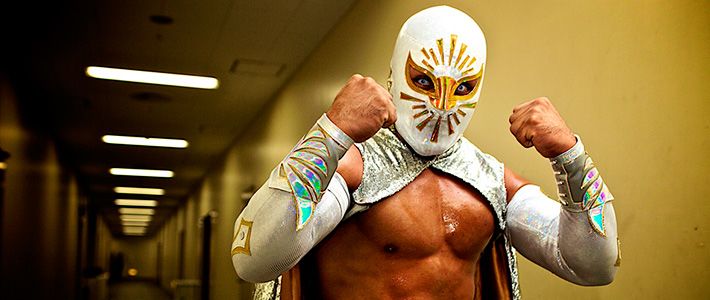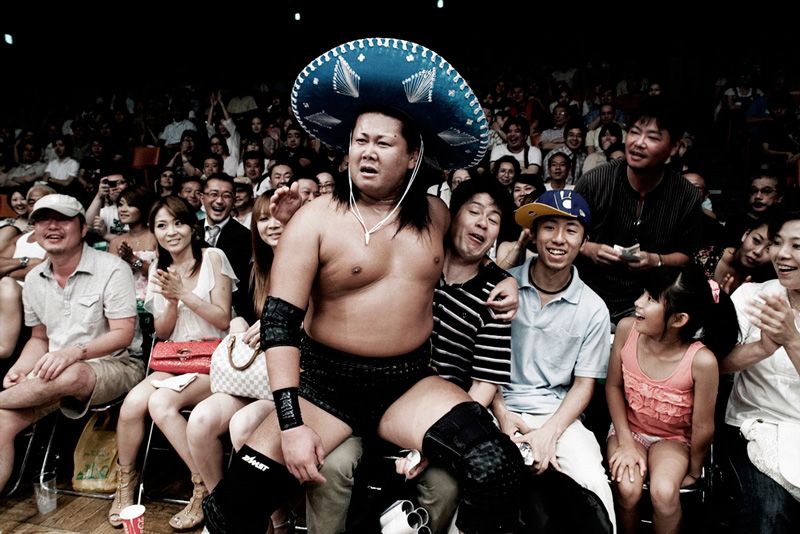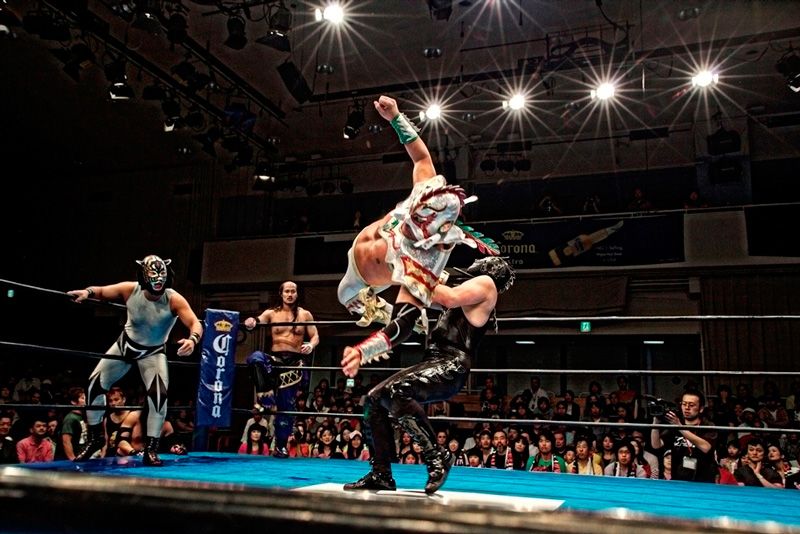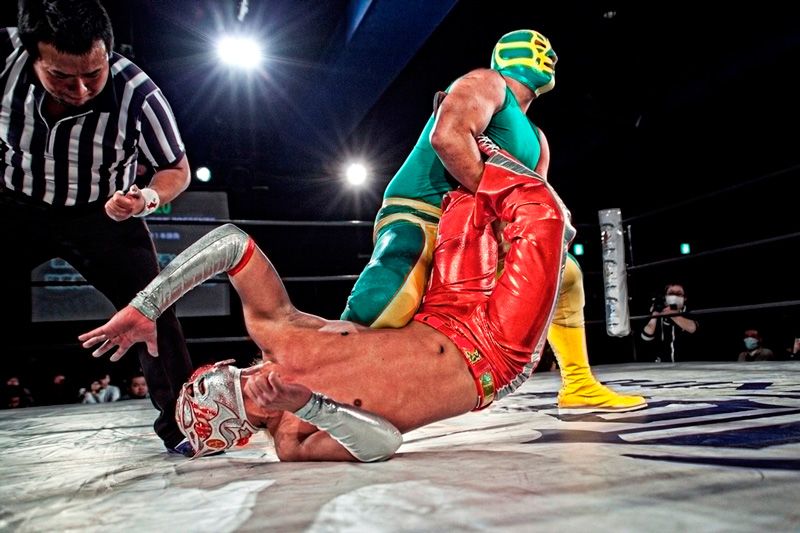
Behind the Mask: Revealing the Ties Between Pro Wrestling in Mexico and Japan
Culture- English
- 日本語
- 简体字
- 繁體字
- Français
- Español
- العربية
- Русский
I have lived in Japan for almost 13 years now. Throughout that time, my own name has been a consistent headache. “Romero” may not seem that much of a mouthful, but for some reason people just don’t seem to be able to get it right. It would all have been so much easier if I had been a Martinez, a Cabrera, or a Fernández—all Hispanic surnames more familiar to the Japanese. Then there are those who seek to draw connections. When quizzed about my links to George A. Romero, the US director famous for his zombie movies, I glibly state that I have not seen the 1968 Night of the Living Dead.
Japan’s Most Famous Mexican
I have also been asked if my name has any connection to the “Romero Special,” a wrestling maneuver known in Mexico as “la Tapatia.” The creator of this technique was the Mexican professional wrestler Rito Romero (1927–2001), who was also once the trainer of a fighter who—the recent fame of Japan’s national soccer team coach Javier Aguirre notwithstanding—is surely the most famous Mexican in Japan: a certain Aaron Rodríguez Arellano, better known as Mil Mascaras (1942–).
 Japanese wrestler Ōwashi Tōru sporting a sombrero. (© Rodrigo Reyes Marin)
Japanese wrestler Ōwashi Tōru sporting a sombrero. (© Rodrigo Reyes Marin)
While I personally am not a particular fan of wrestling and other combat sports, I am profoundly interested in the impact that the spectacle they call lucha libre (literally “free wrestling”) has exerted over the years on Mexican popular culture. Professional wrestling enjoys great popularity all over the world, but Mexico is one country where it has developed into a genuinely profitable industry.
The Saintly Superhero
Along with Japan and the United States, Mexico has for many years been regarded as one of the three Meccas of professional wrestling. Some theories, though poorly supported, suggest that the sport arrived in Mexico during the Second Franco-Mexican War (1861–67). What we can say with certainty is that wrestling was originally imported into the country from America.
The appearance of the first boxing rings early in the twentieth century provided the perfect platform for wrestling to grow. And in the 1950s, the construction in Mexico City of the Arena Coliseo and the Arena México created the conditions that allowed lucha libre to flourish independently into one of the nation’s most popular sports.
Of course, the success of wrestling as a sport was due in large part to the popularity of the wrestlers, or luchadores, themselves. Among the best loved were El Santo (“The Saint,” 1917–84), Black Shadow (1921–2007), Blue Demon (1922–2000) and Huracán (“Hurricane”) Ramírez (1926–2006). Many of these men eventually starred in their own comics and action movies. El Santo in particular came to be viewed as something of a superhero in a time when the Mexican police were widely seen as corrupt and incompetent. His popularity was so great that many of his fans became unable to distinguish between the fighter himself and the fantastical storylines built around him.
The Japanese Wrestlers Who Made Their Names in Mexico
The defining features of Mexican wrestling include spectacular special moves, a wealth of acrobatic maneuvers, a division of the wrestlers into technically proficient faces (heroes) and rugged heels (villains), and, famously, the use of masks. There are many wrestlers who are never seen in public without their masks, even going so far as to attend the annual National Sports Award Ceremony—held each December at the Presidential Palace—in character.
At present, there are two separate professional wrestling associations, each with its own stable of fighters. One is the Consejo Mundial de Lucha Libre (literally “World Wrestling Council,” CMLL for short), established in 1933 and the oldest professional wrestling association in the world. The other is the Asistencia Asesoría y Administración (literally “Assistance, Advice, and Administration,” AAA for short). The rosters of the respective organizations include wrestlers from overseas as well as Mexican luchadores. To date, the two best-known Japanese wrestlers to ply their trade in Mexican rings have been Gran Hamada (1950–) and el Último Dragón (“the Last Dragon,” 1966–).
 Último Dragón vs. Dragón Negro at the “Lucha Fiesta 2010,” held at Tokyo’s Kōrakuen Hall. (© Rodrigo Reyes Marin)
Último Dragón vs. Dragón Negro at the “Lucha Fiesta 2010,” held at Tokyo’s Kōrakuen Hall. (© Rodrigo Reyes Marin)
The Legion of Luchadores Who Put Down Roots in Japan
Professional wrestling is thought to have come to Japan from the United States in the 1920s, but it was during the years of the Allied occupation (1945–52) that the sport began to find popularity. Then, in the 1950s, with the establishment of the Nippon Puroresu Kyōkai (Japan Pro Wrestling Association) and the emergence of Korean-born star and former sumō wrestler Rikidōzan (1924–63), wrestling exploded into the mainstream, becoming one of the most popular sports in postwar Japan and for a time creating a buzz that rivalled even sumō and baseball. And this success resulted in a steady stream of wrestlers coming to Japan from the United States, Latin America, and elsewhere, seeking fame and fortune.
An overwhelming proportion of the Latin American athletes who came to wrestle in Japan were from Mexico. Although it is difficult to confirm beyond doubt, it is thought that the first Mexican to grace the Japanese ring was Sergio Romero, a masked wrestler whose signature move was the Tapatia.
Many of Romero’s countrymen followed him to Japan, and most elected to remain in this country. The most successful of the bunch was Mil Mascaras, although his brothers Dos Caras (“Two Faces,” 1951–), Canek (1952–), and Perro (“the Dog”) Aguayo (1946–) also made an impact.
Among the other names worth mentioning were Huracán Ramirez, Ray Mendoza (1929–2003), Villano Tercero (“the Third Villain,” 1952–), Villano Cuarto (“the Fourth Villain,” 1965–), Villano Quinto (“the Fifth Villain,” 1962–), Angel Blanco (“the White Angel,” 1936–86), Ultraman (1950–), El Psicodélico (“the Psychedelic,” 1950–), El Solitario (“the Loner,” 1945–86), Tinieblas (“Darkness,” 1939–), Jerry Estrada (1958–), Cien Caras (“Hundred Faces,” 1949–), Solar (1955–), Doctor Wagner (1936–2004), Pirata Morgan (“the Pirate Morgan,” 1962–), Fishman (1951–), Brazo de Oro (“Golden Arm,” 1959–), and Brazo de Plata (“Silver Arm,” 1963–).
Puroresu and Pop Culture
But despite Japan’s status as one of the hubs of global wrestling, the sport’s popularity in this country has fallen off dramatically in recent years. One reason is the current lack of regular TV coverage. The problem is compounded by the surge in the popularity of soccer, along with other combat sports that have usurped wrestling’s place in the hearts of the public. And sadly, with many of the great wrestlers of yesteryear no longer on the scene, no new stars have emerged who can capture the imagination of the Japanese fans in the same way as Rikidōzan or Giant Baba (1938–99). Some legends have moved away from the sport altogether, with figures such as Antonio Inoki (1943–) and Hase Hiroshi (1961–) even entering the world of politics.
In spite of this decline, however, puroresu is inextricably woven into the fabric of Japanese popular culture. Comedians impersonating past stars like Inoki, Chōshū Riki (1951–), and Mutō Keiji (1962–), are a regular fixture on television, and there are also examples of celebrities from the world of entertainment dabbling in wrestling, their exploits broadcast to a wide audience. The influence of Mexican masked wrestlers is also clear, with a variety of characters and goods co-opting such imagery.
Tiger Mask: A Robin Hood of the Ring in Postwar Japan
Wrestling has also been taken up as a major theme by the world of manga. Perhaps the best example of this tendency is Tiger Mask, which was serialized in the publication Weekly Shōnen Magazine, winning great popularity in the late 1960s and early 1970s. The story centers on Date Naoto, raised in an orphanage and forced by fate to take to the ring as the tale’s eponymous hero, wearing the mask of the beast from which he takes his name. Most fascinating of all was that the key to the protagonist’s success was not some signature punch or kick, but rather his winning mentality. The money Tiger Mask earned from his triumphs was donated to the children’s home in which he spent so much of his life.
But why did this character prove so popular? The Japan of those years had yet to develop into the economic superpower it is today. The depiction of a character who fought for disadvantaged children was a huge success, speaking as it did to the hearts of many Japanese. The lasting impact of Tiger Mask has been such that, even today, some who make donations to orphanages and other causes choose to preserve their anonymity by using the soubriquet “Date Naoto.”
Priestly Parallels
There is a real-life Mexican wrestler whose tale bears some striking similarities to Date’s fictional life. Fray Tormenta (“Friar Storm”) was a masked priest who fought in the ring to support the children of his orphanage. This wrestler, real name Sergio Gutierrez Benitez (1945–), was inspired to such a radical gesture not by Tiger Mask, but by the 1962 Mexican movie El Señor Tormenta (“The Storm Lord”). The film starred Julio Aldama (1931–89) and Eric Del Castillo (1930–) alongside actual wrestlers like Rito Romero, Black Shadow, and Ray Mendonza in its portrayal of a priest battling to save the children of his orphanage.
 El Hijo de Fishman (“Son of Fishman”) applies a leglock to Hurricane Kid at the event “Fukumen Mania 20,” held at Shinjuku Face. (© Rodrigo Reyes Marin)
El Hijo de Fishman (“Son of Fishman”) applies a leglock to Hurricane Kid at the event “Fukumen Mania 20,” held at Shinjuku Face. (© Rodrigo Reyes Marin)
Fray Tormenta made his ring debut in 1974 and fought on until his retirement in 2011, despite the disapproval of many Catholic groups. It is amazing that stories as similar as those of Date Naoto and Fray Tormenta should have arisen in roughly the same era in two countries so far apart. Incidentally, starting in 1994, Weekly Shōnen Magazine also ran a story based on the tale of Mexico’s grappling holy man, and in 2006 Jack Black starred in the (to my mind, poor) film Nacho Libre, clearly inspired by the life of Fray Tormenta.
Even after Fray Tormenta’s retirement , one of the boys who had been in his care at the orphanage decided to continue his legacy by donning the famous mask to become Fray Tormenta Jr. Examples of children who follow a parent (like the Son of El Santo) or a mentor into the ring are common in Mexican wrestling, though in this particular case Fray Tormenta Jr. has proved unable to scale the same heights as his father figure, even while carrying the flame for his noble objectives.
What Is Lacking in Japanese Wrestling
As well as guiding the career of his real-life protégé, in 2004 Fray Tormenta as trainer was also written by the CMLL into the elaborate backstory of the wrestler Místico (1982–). This young, acrobatic masked fighter, dubbed “The Prince of Silver and Gold,” was a huge success, even drawing comparisons to El Santo himself. But, in 2011, he was finally spirited away to the north in a big-money deal with the American group World Wrestling Entertainment, where—despite his mask—he was repackaged as a face, ironically named Sin Cara (meaning “faceless”). Eager not to let the success of Místico slip, Fray Tormenta and the CMLL put their heads together to launch a successor, Místico II (1991–), who soon picked up where his predecessor left off.
Perhaps this is what is missing in Japanese wrestling: a father figure like Fray Tormenta. Although I know not what lies ahead for the sport in my adopted country, if the popularity of puroresu continues to decline at the current rate, there is a risk that it could disappear altogether. Even if that should prove to be the case, however, I am sure that wrestling will live on through the influence that it continues to exert on Japanese popular culture. And who knows? Perhaps, somewhere in Japan, the next Date Naoto might just be waiting in the wings, ready to step from the shadows and save his sport by wrestling for the poor.
References
Loudes Grobet. 2005. Espectacular de lucha libre [The Spectacle of Professional Wrestling]. Trilce.
Raúl Criollo, José Xavier Návar, Rafel Aviña. 2011. ¡Quiero ver sangre! Historia ilustada del cine de luchadores [I Want to See Blood! An Illustrated History of Wrestling Movies]. UNAM.
Heather Levi. 2008. The World of Lucha Libre: Secrets, Revelations and Mexican National Identity. Duke University Press.
Shōwa puroresu kenkyūshitsu [The Shōwa Wrestling Lab]. http://showapuroresu.com/.
(Banner photo: Mexican masked wrestler Místico. © Rodrigo Reyes Marin.)
martial arts entertainment sport Wrestling pro wrestling Mexico